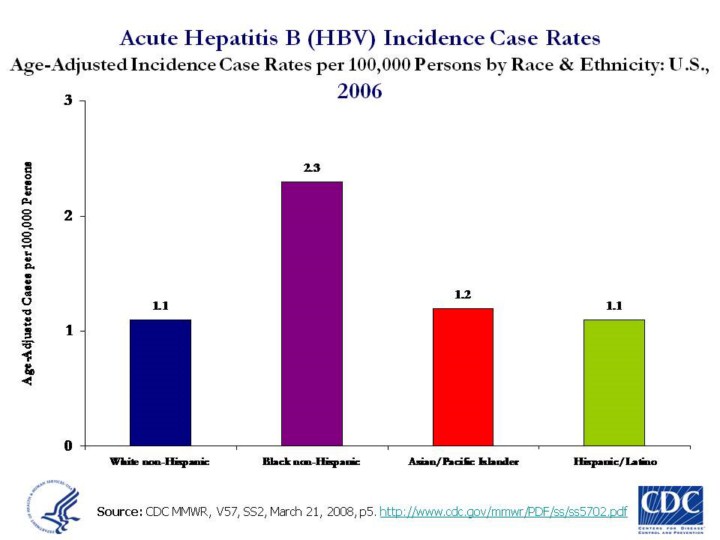| front |1 |2 |3 |4 |5 |6 |7 |8 |9 |10 |11 |12 |13 |14 |15 |16 |17 |18 |19 |20 |21 |22 |23 |24 |25 |26 |27 |28 |29 |30 |31 |32 |33 |34 |35 |36 |37 |38 |39 |40 |41 |42 |43 |44 |45 |46 |47 |48 |49 |50 |51 |52 |53 |54 |55|56 |57 |58 |review |
 |
Updated 6/2/08 by SB Age-Adjusted Incidence Case Rates per 100,000 Persons by Race/Ethnicity for Acute Hepatitis B: U.S., 2001 Viral hepatitis has historically been common in American Indian/Alaska Native (AI/AN) communities. However, the number of viral hepatitis infections in these communities has been reduced. In 2001, 86% of AI/AN children ages 19-35 months had received the hepatitis B vaccine, compared with 89% of the total population. In that same year, 1.86 per 100,000 AI/AN were reported with acute HBV, compared with 1.31 per 100,000 white non-Hispanic Americans (20). In 2002, 50 percent of those infected with HBV were Asian American or Pacific Islander (AAPI). Black teenagers and young adults become infected with Hepatitis B three to four times more often than those who are white. (21)
Immunization with hepatitis B vaccine is the most effective means of preventing hepatitis B virus (HBV) infection and its consequences. However, while the rate of acute HBV among AAPIs has been decreasing, the reported rate in 2001 was more than twice as high among AAPIs (2.95 per 100,000 population) as among white Americans (1.31 per 100,000 population). In 2001, 90% of AAPI children ages 19-35 months had received hepatitis B vaccine, compared with 89% of the total population. For Hispanic/Latino children, as for African American children, disparities have been closed or greatly reduced for most vaccines. (20)
-- The highest rates of new
and long-term HBV infections occur among African Americans.
Slide source (22) Source: CDC MMWR, V57, SS2, March 21, 2008, p5. http://www.cdc.gov/mmwr/PDF/ss/ss5702.pdf |